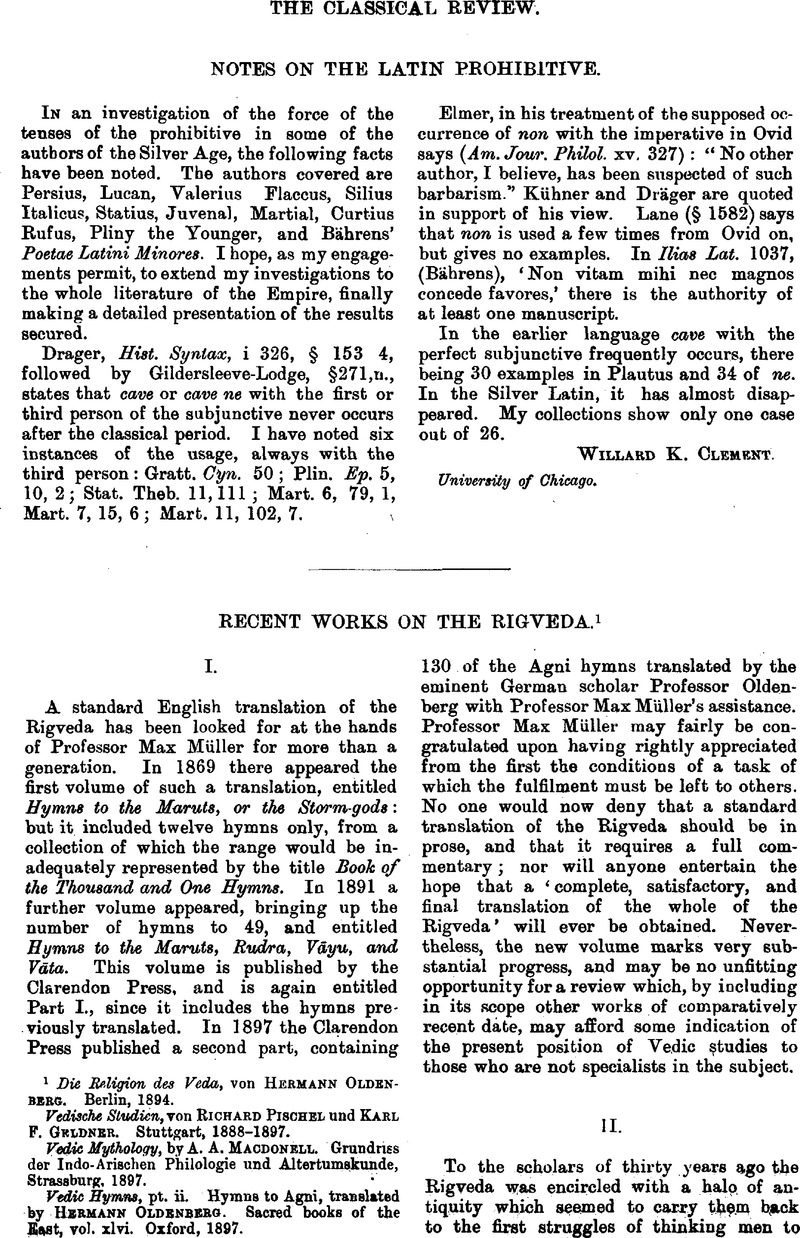No CrossRef data available.
Article contents
Recent Works on the Rigveda1
Published online by Cambridge University Press: 27 October 2009
Abstract

- Type
- Original Contributions and Comptes Rendus
- Information
- Copyright
- Copyright © The Classical Association 1900
References
page 57 note 1 The ‘primitive’ character of nature-worship in the sense referred to is of course no longer generally assumed. Cf. Smith, Robertson, Religion of the Semites, p. 127Google Scholar. “Among the Semites the worship of sun, moon and stars does not appear to have had any great vogue in the earliest times. Among the Hebrews there is little trace of it before Assyrian influence became potent, and in Arabia it is by no means so prominent as is sometimes supposed,”
page 57 note 2 Religion des Veda, pp. 108, 109.
page 57 note 3 The evidence is also collected by ProfessorMacdonell, , Vedic Mythology, pp. 92, 93Google Scholar. This writer candidly admits the comparative rareness of such allusions.
page 58 note 1 The discussion in A. Ludwig's Rigveda, vol. iii seems to me still to hold the field.
page 58 note 2 Religion des Veda, p. 185.
page 58 note 3 id. pp. 185, 186.
page 58 note 4 id. p. 189.
page 58 note 5 See Ludwig's admirable ‘remarks, Rigveda, iii pp. 314–317.
page 58 note 6 Rigveda, iv. 13, 2.
page 58 note 7 The use of fire as an instrument of worship is certainly very consistent with the supposition that a celestial deity was at the same time its object. Cf. Smith, Robertson, Religion of the Semites, p. 107Google Scholar. “In later times celestial gods predominatem, as we see from the prevalence of sacrifice by fire, in which the homage of the worshipper is directed upwards in the pillar of savoury smoke that rises fromt eh altar towards the seat of the godhead in the sky.”
page 58 note 8 The conception of Dyaus is however changed. He ceases to be closely associated with the physical heaven: he becomes ‘Father’ and ‘Lord’ : and his residence is in ‘the highest place. The history of this development is admirably treated in Bradke's pamphlet Dyaus Asura und die Asuren. The Dyaus who appears in the Rigveda by the side of Prithivi (earth) appears to be practically a new deity of lower rank.
page 59 note 1 See the preceding note.
page 59 note 2 Religion des Veda, p. 128.
page 59 note 3 ib. p. 103.
page 59 note 4 Ib. p. 105.
page 59 note 5 Pischel, and Geldner, , Vedisehe Studien, Introduction, p. xxviiGoogle Scholar.
page 60 note 1 Apām Napāt.
page 60 note 2 Religion des Veda, p. 121.
page 60 note 3 Religion da Veda, p. 112.
page 60 note 4 Introduction to Part I., p. xxvii.
page 60 note 5 The ‘anima’ of Lucretius.
page 60 note 6 Vedische Studien, ii. p. v.
page 60 note 7 Ib. p. 322.
page 61 note 1 Ib. p. iv.
page 61 note 2 Ib. p. 268.
page 61 note 3 Ib. p. 244.
page 61 note 4 The principle is thus stated in Vedische Studien, ii. p. 243. ‘If I find that the interpretation of a word or phrase which is established in classical Sanskrit or is given by the lexicographers snits all passages in which the word or phrase occurs in the Veda, I interpret the Veda accordingly: If it does not suit them, I abandon the interpretation and go my way without tronbling about classical Sanskrit or the lexicographers.’
page 61 note 5 Rigveda, vol. i. (1869), pp. 230 seg.
page 61 note 6 V.S. ii. p. 86.
page 61 note 7 Vedic Mythology, p. 122.
page 61 note 8 So Oldenberg remarks (Religion des Veda, p. 203) that the goddess Aditi is, historically considered, younger than her children. How he reconciles this statement with his own view that Adifi is a ‘cowgoddess or rather cow-fetish belonging to a very low grade of myth-formation’ I do not know.
page 62 note 1 V.S. ii. p. 271.
page 62 note 2 Religion det Veda, p. 193.
page 62 note 3 Vedische Studien, i. p. xxvii.
page 62 note 4 Ib. ii. p. 125.
page 62 note 5 Ib. p. 292.
page 62 note 6 Ib. p. 292, note.
page 62 note 7 Rigveda, vii. 64, 1, 2.
page 62 note 8 Vedische Studien, ii. p. 281.




